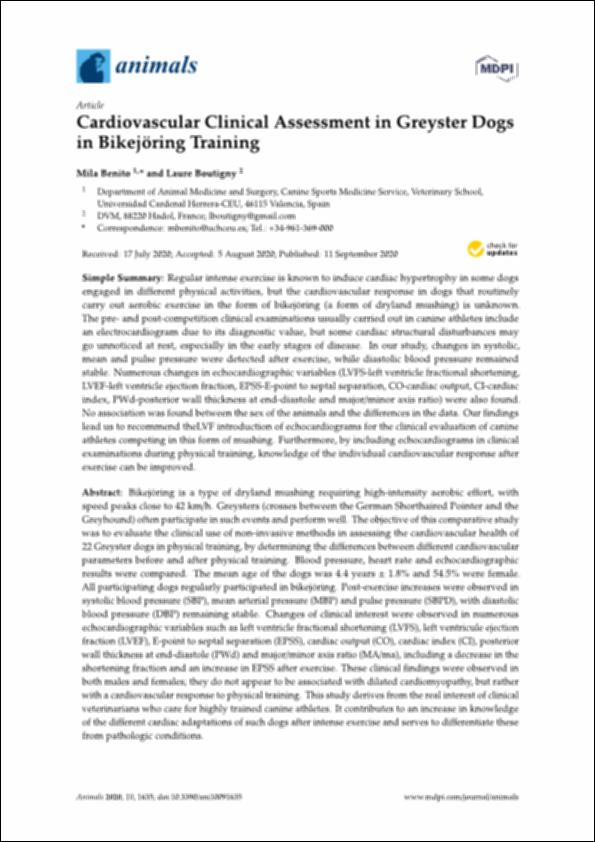Please use this identifier to cite or link to this item:
http://hdl.handle.net/10637/12496Cardiovascular clinical assessment in Greyster dogs in bikejoring training
| Title: | Cardiovascular clinical assessment in Greyster dogs in bikejoring training |
| Authors : | Benito Hernández, Milagros Boutigny, Laure |
| Keywords: | Ecocardiografía en veterinaria.; Veterinary echocardiography.; Dog breeds - Greyster - Cardiovascular system.; Perros - Razas - Greyster - Aparato circulatorio. |
| Publisher: | MDPI |
| Citation: | Benito, M. & Boutigny, L. (2020). Cardiovascular clinical assessment in Greyster dogs in bikejöring training. Animals, vol. 10, i. 9 (11 sep.), art. 1635. DOI: https://doi.org/10.3390/ani10091635 |
| Abstract: | Bikejöring is a type of dryland mushing requiring high-intensity aerobic effort, with speed peaks close to 42 km/h. Greysters (crosses between the German Shorthaired Pointer and the Greyhound) often participate in such events and perform well. The objective of this comparative study was to evaluate the clinical use of non-invasive methods in assessing the cardiovascular health of 22 Greyster dogs in physical training, by determining the differences between different cardiovascular parameters before and after physical training. Blood pressure, heart rate and echocardiographic results were compared. The mean age of the dogs was 4.4 years ff. 1.8% and 54.5% were female. All participating dogs regularly participated in bikejöring. Post-exercise increases were observed in systolic blood pressure (SBP), mean arterial pressure (MBP) and pulse pressure (SBPD), with diastolic blood pressure (DBP) remaining stable. Changes of clinical interest were observed in numerous echocardiographic variables such as left ventricle fractional shortening (LVFS), left ventricule ejection fraction (LVEF), E-point to septal separation (EPSS), cardiac output (CO), cardiac index (CI), posterior wall thickness at end-diastole (PWd) and major/minor axis ratio (MA/ma), including a decrease in the shortening fraction and an increase in EPSS after exercise. These clinical findings were observed in both males and females; they do not appear to be associated with dilated cardiomyopathy, but rather with a cardiovascular response to physical training. This study derives from the real interest of clinical veterinarians who care for highly trained canine athletes. It contributes to an increase in knowledge of the di erent cardiac adaptations of such dogs after intense exercise and serves to differentiate these from pathologic conditions. |
| Description: | Este artículo se encuentra disponible en la siguiente URL: https://www.mdpi.com/2076-2615/10/9/1635 Este artículo pertenece al número especial "Sports medicine and rehabilitation in companion animals: from lameness diagnosis to treatment and prevention". |
| URI: | http://hdl.handle.net/10637/12496 |
| Rights : | http://creativecommons.org/licenses/by/4.0/deed.es |
| ISSN: | 2076-2615 (Electrónico). |
| Issue Date: | 11-Sep-2020 |
| Center : | Universidad Cardenal Herrera-CEU |
| Appears in Collections: | Dpto. Medicina y Cirugía Animal |
Items in DSpace are protected by copyright, with all rights reserved, unless otherwise indicated.


